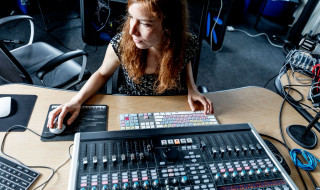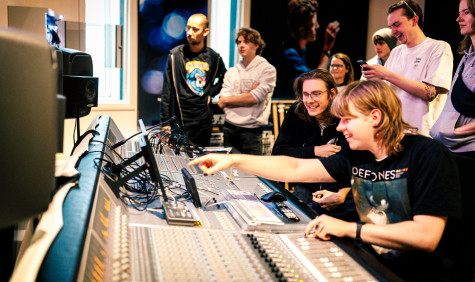'Making music without delay on the network with artists around the world'
ArtEZ students make live music together from three locations
Students from the university of applied sciences ArtEZ make live music together without being on the same stage. Audio studios in different locations of the university of applied sciences are permanently connected virtually, allowing jamming on the network without delay.
There Alexander Pielsticker, fourth-year Composition for film & theatre (CFT) student at ArtEZ Arnhem, stands before the orchestra like an accomplished conductor. On the cinema screen, the rat from the animated film Ratatouille tries to get rid of its pursuer. The music Alexander composed for this and other film scenes has to be played live at the right time not only in the concert hall in Arnhem, but also in ArtEZ's audio studios in Enschede and Zwolle, where musicians are lined up for Alexander's graduation project. Friends and family in Germany follow the concert via a livestream.
'During my final undergraduate year, I had often and intensively thought about the idea of making music with artists all over the world without delay on the network,' Alexander explains. 'Combining 'real-time' virtual music with the medium of film seemed like a logical next step.' Alexander succeeds and is a professional experience richer.
'The 4th location allows live ensemble playing over long distances with all the instrument groups ArtEZ conservatoire has, without delays,' says lecturer and project leader Tjerk de Groot. 'We can form complete orchestras, even though they are physically spread over three cities. That's great is for our education.'
Minimal delay
The 4th location is a virtual ring of which the audio studios in the Enschede, Arnhem and Zwolle locations are a permanent part. This makes it possible for musicians from all locations to collaborate, while in Enschede a good audio mix is made that can be streamed live. This is possible because ArtEZ decided to upgrade the network in 2017, with connections going from 1 to 10 Gigabits. Bert Kremer, head of IT at ArtEZ, compares the new network to a motorway with 10 lanes, five of which are reserved for the conservatoire. This is necessary because there should be as little latency, delay, as possible during a performance.
'Band members standing in the same room look at each other a lot,' Kremer says. 'You signal each other and sense each other. But if there is a delay of more than 20 milliseconds (comparable to 7 metres of physical distance), musicians can hear it and don't play well with each other.' On ArtEZ's ten-lane road, signals over SURF's fibre-optic network can be sent from Arnhem to Enschede within 5 milliseconds with ease.

"To make music together remotely, you need professional equipment, the SURF network, and a permanent setup at fixed locations."
Professional equipment
'Besides the five lanes for the musicians, a sixth lane goes from Enschede back to Arnhem, where the signal enters the Internet via the SURF connection,' Kremer explains. 'From Arnhem it goes to Enschede and Zwolle, from Zwolle back to Arnhem and from Arnhem back to Enschede. At all three stops there are musicians playing. Despite the distance the signal travels, it has to stay within that latency limit.'
To achieve that, ArtEZ uses equipment also used by the global broadcast industry. That ensures that the sound is sent so lightning-fast that it is equalised, despite the 80 kilometres it travels. ArtEZ is the first conservatoire in Europe to use this technology.
Cross-overs
The reason for starting the virtual studio was both practical and creative. ArtEZ's classical music programme is getting smaller and smaller. For instance, only a few students still play harp at ArtEZ. These Zwolle students do not have to board the train with their large instrument for every workshop or performance. At the same time, the institution wants to stimulate the creative process. Put a bassoon player next to a rapper and crossovers, mixing of musical styles, emerge. That process is simplified if students do not have to travel.
Permanent arrangement
The arrival of corona accelerated the creation of the 4th venue. 'Everyone recognised that this project had to be prioritised,' says Kremer. 'With consumer products like Teams and Zoom, professional musicians can't do anything. To make music together remotely, you need professional equipment, the SURF network, and a permanent setup at fixed locations.'
The latter is a lesson learned with difficulty. By now, all locations have permanent set-ups. In corona time, two students graduated using the technology.
'Because all universities of applied sciences and universities are in the same network system, the basic infrastructure is already there. That is the prerequisite for cooperation'
Making it more user-friendly
According to Kremer, the 4th location is only possible because Dutch education cooperates particularly well. 'We have SURF. Because all universities of applied sciences and universities are in the same network system, the basic infrastructure is already there. That is the prerequisite for cooperation.' Plans to also connect the other Dutch conservatoires to the 4th location are at an advanced stage. There is also contact with British and Swedish conservatoires. 'Due to its scalability, the 4th location will eventually form a bridge to the outside world,' says Tjerk de Groot.
Hard work is being done to make access to the 4th location accessible to students. That this was not yet the case for Alexander does not bother him. He says: 'Not everything went according to plan, which makes sense when so many people are involved and so many technical skills are involved. But for me, it was one of the most incredible, unique experiences I have ever had.'
Text: Marjolein van Trigt
Photos: ArtEZ - University of the Arts
